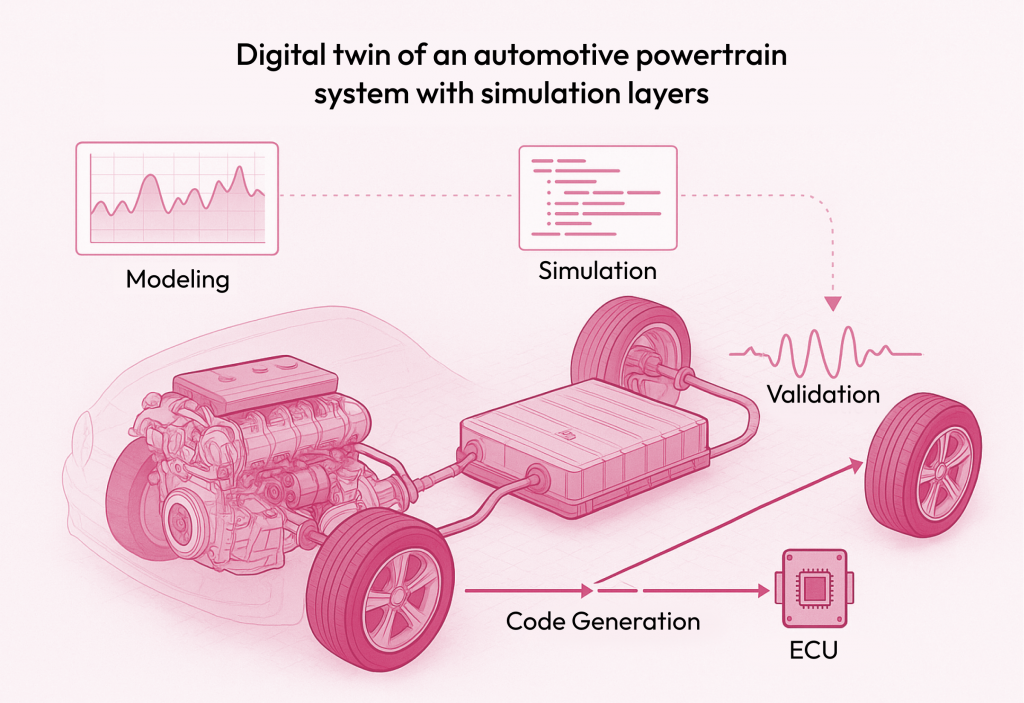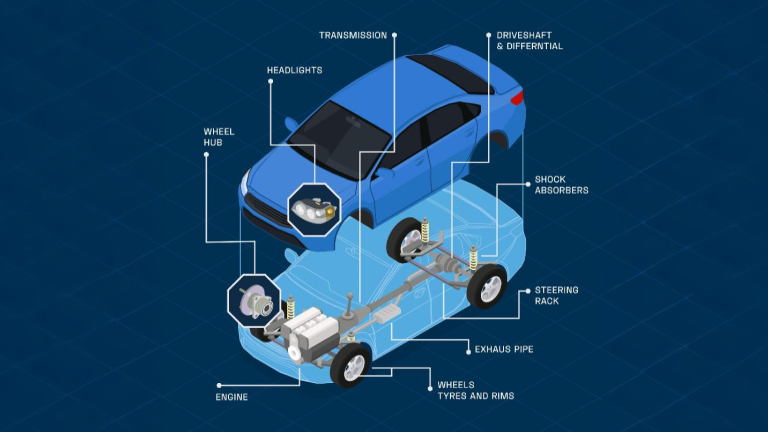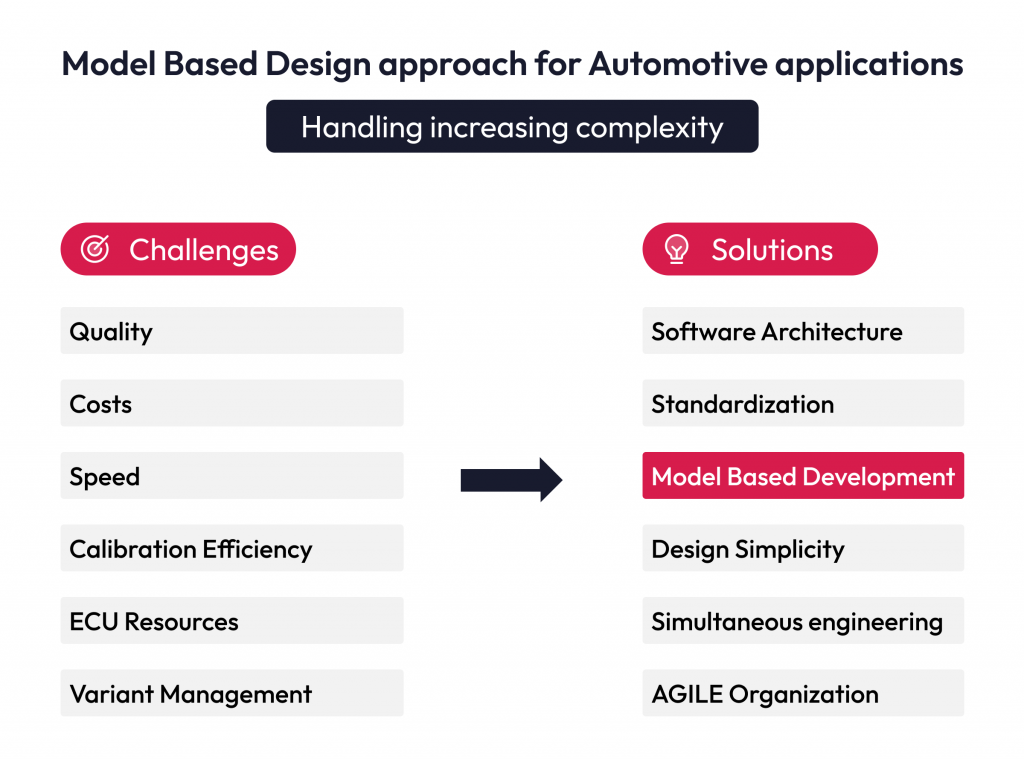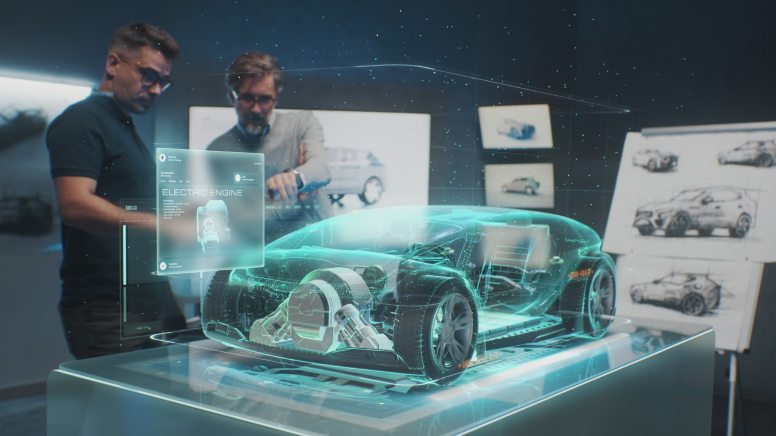The automotive industry is pivoting to a transformative phase resulting from a shift to electrification, tighter emission regulations, and the growing complexity of vehicle software. By 2030, the share of electric cars is set to surpass 40% in overall car sales. So, automotive OEMs and Tier 1 suppliers experience increased pressure to deliver optimized, robust EV (electric vehicle) powertrain systems faster and at less cost. Consequently, optimizing automotive powertrain systems has become a critical process that organizations must keep in check to enhance vehicle performance and ensure compliance with stringent environmental regulations.
Model-Based Design (MBD) is an engineering methodology in which mathematical models are used to design, simulate, verify, and validate the behaviour of powertrain systems before hardware implementation. It enables the use of digital twins on top of integrated simulations to facilitate iterative design and testing in a virtual environment.
This article explores how Model-Based Design changes automotive powertrain development, delivering measurable ROI to engineering organizations while supporting long-term digital transformation initiatives like Model-Based Systems Engineering (MBSE) and digital twins.
The strategic imperative of Model-Based Design for automotive powertrain systems development
The powertrain—comprising the internal combustion engines (ICE), transmission, and drivetrain—is the heart of any vehicle. Optimizing its performance is a balancing act involving emissions compliance, fuel efficiency, cost control, and consumer satisfaction. Traditional development methods rely heavily on physical prototypes and sequential testing and are increasingly inadequate. They are slow, expensive, and prone to late-stage discovery of faults.
Model-Based Design is an engineering methodology in which mathematical models are used to design, simulate, verify, and validate the behaviour of powertrain systems before hardware implementation. It enables the use of digital twins and integrated simulations and facilitates iterative design and testing in a virtual environment.

At the core, it involves:
- System modelling and architecture definition: Simulating various interactions of whole powertrain components.
- Plant modelling: Engine thermodynamics, motor behaviour, battery systems.
- Control algorithm design: Torque control, gear shift logic, energy management.
- Simulation & testing: Test and refine models by employing Model-in-the-Loop (MIL), Hardware-in-the-Loop (HIL), and Software-in-the-Loop (SIL) frameworks.
- Verification and validation: System behaviour validation of powertrain design under various conditions for safety compliance like ISO 26262.
- Automatic code generation: Automatic generation of production-ready code from system models for Electronic Control Units (ECUs) production using tools like MATLAB/Simulink and dSPACE.
Components of Model-Based Design for automotive powertrain systems
- System Modelling
Model-based workflows start with system modelling at the level of system dynamics of the whole powertrain. These models are used in shared environments like MATLAB/Simulink, allowing engineers to simulate the interactions of various components like the engine, transmission, and hybrid systems with one another. This system-based approach will help identify bottlenecks and optimize performance under different operating conditions. - Control Algorithm Development
Robust control systems are the key to achieving high performance in the powertrains. MBD allows teams to design, test, and refine the control algorithms in simulation. For example, calibrating the engine control units for enriching combustion efficiency or the battery management system for electric vehicles could be carried out without physical prototypes. - Automatic Code Generation
The MBD process generates production-quality code to translate design models using tools like Embedded Coder, which helps automate the development process. A significant advantage of this is supporting AUTOSAR-compliant architectures for ECU integration, minimizing errors, and accelerating functional deployment to ECUs. - Simulation & Validation
Powertrains operate on different physical phenomena, which extend to thermal, mechanical, and electrical dynamics. MBD platforms integrate these domains to assess trade-offs and ensure that designs meet efficiency standards, durability, and regulations. The model behaviour is tested in several frameworks, such as MIL, SIL (software-in-the-loop), and HIL, to achieve model validation through the stages of development.
Case in point: Realizing efficiency in hybrid powertrains
Consider a manufacturer that designs and builds a hybrid electric powertrain. A traditional method would likely involve constructing several prototypes to evaluate different power distribution strategies, thermal management, and emissions compliance.
With MBD:
- Engineers can model the whole hybrid system virtually and simulate different driving conditions.
- They can digitally design and validate control strategies for energy management.
- Optimizing thermal performance with multi-physics simulations guarantees that the battery will last longer and consume less energy.
- HIL testing helps them validate the integration of highly integrated software and hardware.
This approach reduces the need for physical testing and enables the rapid exploration of “what-if” scenarios, such as varying battery sizes or electric motor configurations.
Implementation challenges and strategic considerations
The advantages of MBD are apparent, but its implementation involves overcoming both organizational and technical hurdles.
- Skill Gaps: Effective adoption of MBD heralds the upskilling of team members in workflow and simulation tools.
- Toolchain Integration: Organizations must ensure seamless integration between MBD platforms and existing tools.
- Cultural shifts: Transforming from prototype-driven to simulation-based development demands cultural buy-in from all stakeholders.
Top executives play a significant role in overcoming this barrier. Investment in training, provision of cross-disciplinary collaboration, utilization of offshore engineering, and flexible, scalable MBD tools will ensure a smooth transition.
A competitive imperative
Model-Based Design stands out as an engineering methodology and a competitive differentiator in the ever-increasing competition for intelligent, green, and software-oriented vehicles. It allows automotive companies to bridge the gap between concept and production to innovate powertrain systems with high safety or compliance.
Simulation and automation embedded at the centre of powertrain development offer transformational value to engineering leaders through reduced costs, faster delivery, and futureproofing of their mobility systems for the next decade. As a trusted partner in Embedded Engineering solutions, we enable Automotive OEMs, innovators, and Tier 1 suppliers to harness the power of simulation for high-performance powertrain design innovation.







